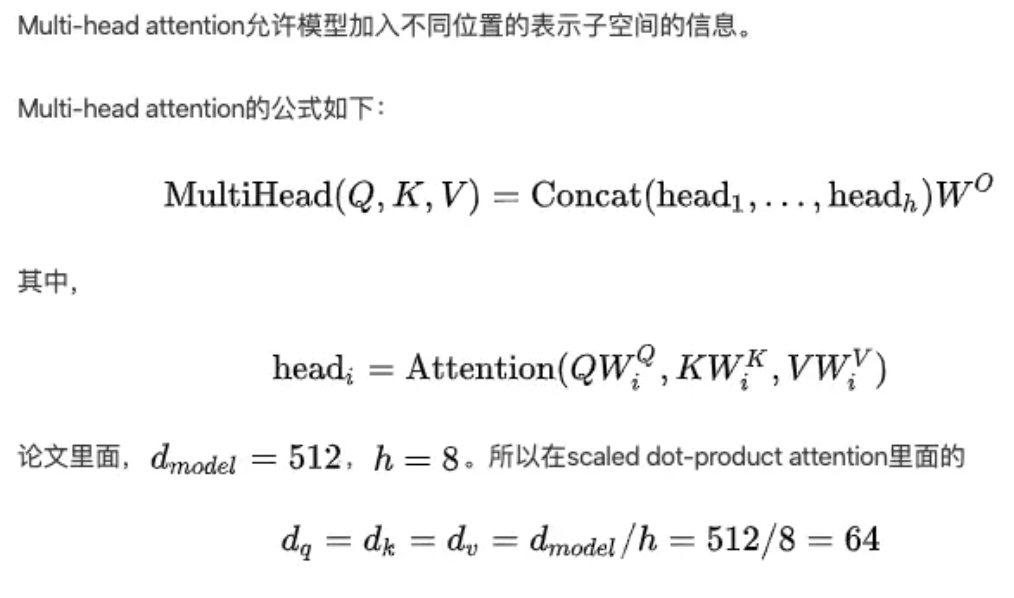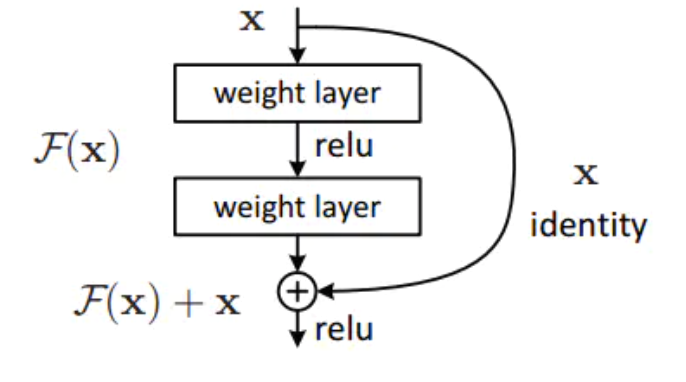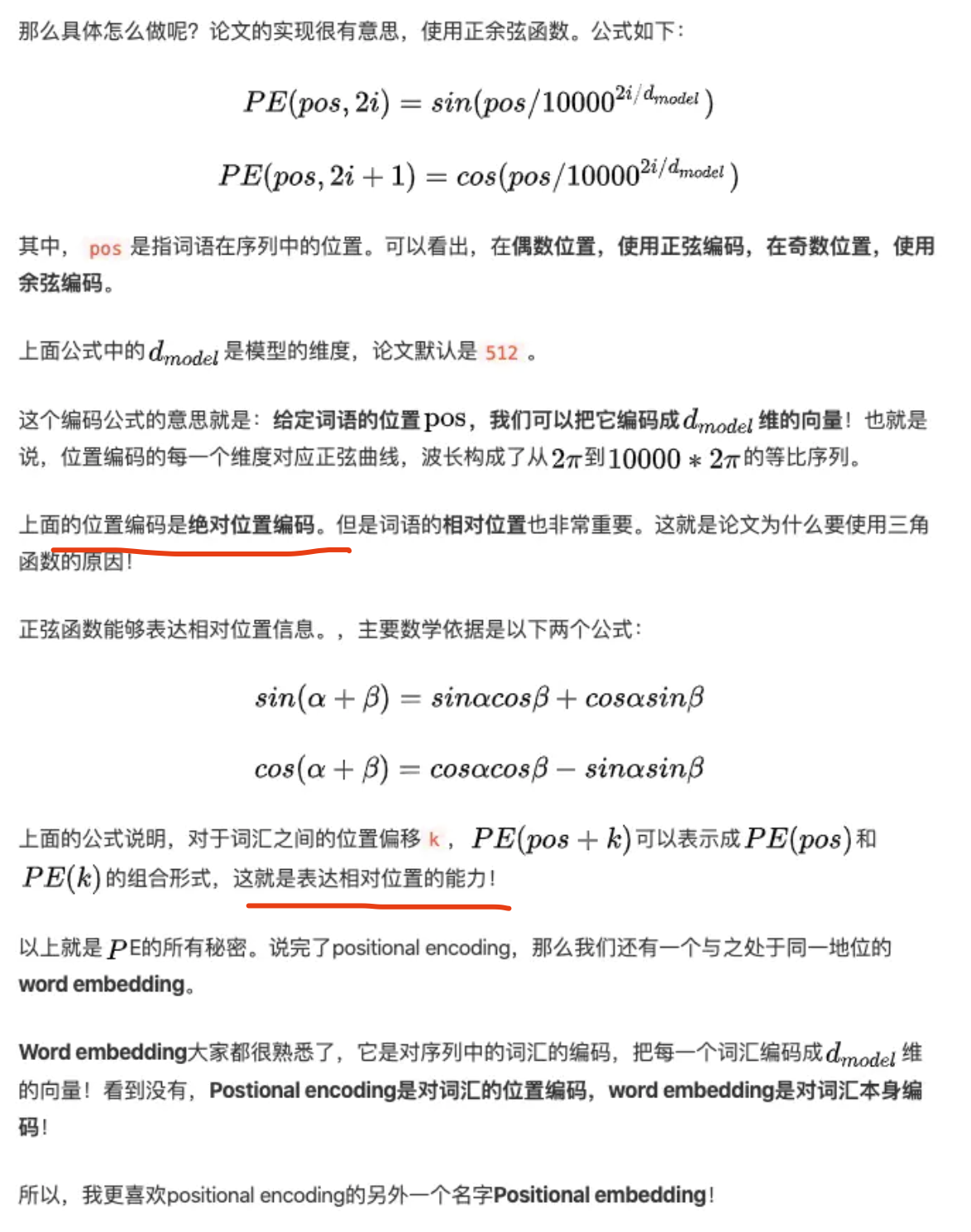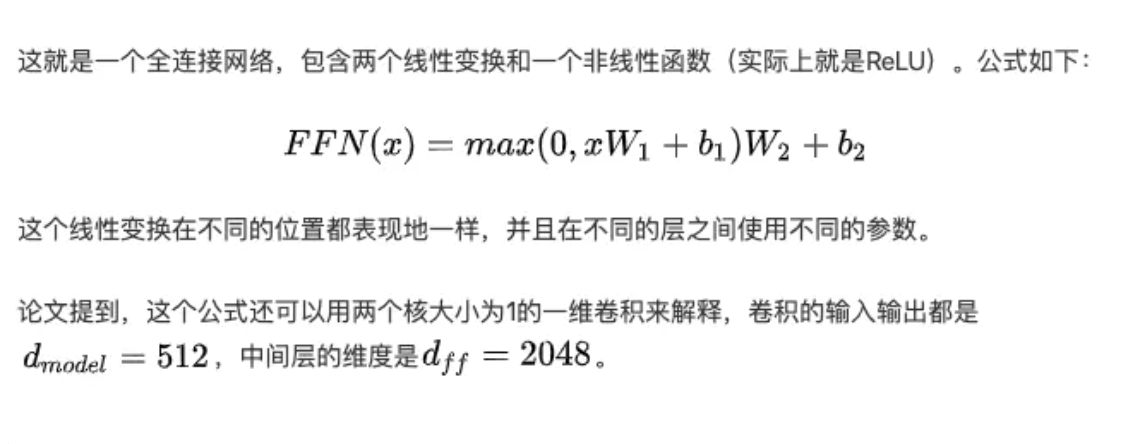简介
论文地址:https://arxiv.org/abs/1706.03762
该论文提出了Transformer模型,完全基于Attention mechanism,抛弃了传统的RNN和CNN,是第一个只依赖于自注意力来做encoder-decoder架构的模型,可谓是大道至简!
先整体看一下架构图,

对于上图左边的Nx标注出来的部分,就是encoder的一层,一共有6层。同理右边的decoder也是。
输入序列经过word embedding和positional encoding相加后,输入到encoder。
输出序列经过word embedding和positional encoding相加后,输入到decoder。
最后,decoder输出的结果,经过一个线性层,然后计算softmax。
Encoder
encoder由6层相同的层组成,每一层分别由两部分组成:
- 第一部分是一个
multi-head self-attention mechanism
- 第二部分是一个
position-wise feed-forward network,是一个全连接层
两个部分都有一个残差连接(residual connection),然后接着一个Layer Normalization
Decoder
和encoder类似,decoder由6个相同的层组成,每一个层包括以下3个部分:
- 第一个部分是
multi-head self-attention mechanism
- 第二部分是
multi-head context-attention mechanism
- 第三部分是一个
position-wise feed-forward network
- 还是和encoder类似,上面三个部分的每一个部分,都有一个残差连接,后接一个Layer Normalization。
Attention机制
attention是指,对于某个时刻的输出y,它在输入x上各个部分的注意力。这个注意力实际上可以理解为权重。
attension机制有很多种,下面连接有一张较全面的表格:https://lilianweng.github.io/posts/2018-06-24-attention/

上图中,第一种加性注意力(additive attention)在seq2seq模型里面用的很多,但是这里transformer中使用的另外一种乘性注意力(multiplicative attention),即两个隐状态进行点积
Self-Attention


前面说attention机制的时候,都会说两个隐状态:
- $h_i$:输入序列第i个位置产生的隐状态
- $s_t$:输出序列在第t个位置产生的隐状态
所谓self-attention实际上就是,输出序列就是输入序列!因此,计算自己的attention得分,就叫做self-attention!
Context-attention
它是encoder和decoder之间的attention。所以,你也可以称之为encoder-decoder attention。
不管是self-attention还是context-attention,它们计算attention分数的时候,可以选择很多方式,比如上面表中提到的:

Transformer模型采用的是:scaled dot-product attention。
Scaled dot-product attention
通过确定Q和K之间的相似程度来选择V。

论文也提供了结构图:

其中,K和Q和V是一个东西,在之前复制了三份。
- 在encoder的self-attention中,Q、K、V都来自同一个地方(相等),他们是上一层encoder的输出。对于第一层encoder,它们就是word embedding和positional encoding相加得到的输入。
- 在decoder的self-attention中,Q、K、V都来自于同一个地方(相等),它们是上一层decoder的输出。对于第一层decoder,它们就是word embedding和positional encoding相加得到的输入。但是对于decoder,我们不希望它能获得下一个time step(即将来的信息),因此我们需要进行sequence masking。
- 在encoder-decoder attention中,Q来自于decoder的上一层的输出,K和V来自于encoder的输出,K和V是一样的。
- Q、K、V三者的维度一样,即d_q=d_k=d_v
Scaled dot-product attention的实现:
1
2
3
4
5
6
7
8
9
10
11
12
13
14
15
16
17
18
19
20
21
22
23
24
25
26
27
28
29
30
31
32
33
34
35
36
37
38
39
|
import torch
import torch.nn as nn
class ScaledDotProductAttention(nn.Module):
"""Scaled dot-product attention mechanism."""
def __init__(self, attention_dropout=0.0):
super(ScaledDotProductAttention, self).__init__()
self.dropout = nn.Dropout(attention_dropout)
self.softmax = nn.Softmax(dim=2)
def forward(self, q, k, v, scale=None, attn_mask=None):
"""前向传播.
Args:
q: Queries张量,形状为[B, L_q, D_q]
k: Keys张量,形状为[B, L_k, D_k]
v: Values张量,形状为[B, L_v, D_v],一般来说就是k
scale: 缩放因子,一个浮点标量
attn_mask: Masking张量,形状为[B, L_q, L_k]
Returns:
上下文张量和attetention张量
"""
attention = torch.bmm(q, k.transpose(1, 2)) # bmm 是tensor乘法
# 相乘的两个矩阵,要满足一定的维度要求:input(p,m,n) * mat2(p,n,a) ->output(p,m,a)。
# 这个要求,可以类比于矩阵相乘。前一个矩阵的"列"等于后面矩阵的"行"才可以相乘。
if scale:
attention = attention * scale
if attn_mask:
# 给需要mask的地方设置一个负无穷
attention = attention.masked_fill_(attn_mask, -np.inf) # 用value填充tensor中与mask中值为1位置相对应的元素。np.inf 表示+∞
# 计算softmax
attention = self.softmax(attention)
# 添加dropout
attention = self.dropout(attention)
# 和V做点积
context = torch.bmm(attention, v)
return context, attention
|
Multi-head attention
 将Q、K、V通过一个线性映射之后,分成
将Q、K、V通过一个线性映射之后,分成h份,对每一份进行scaled dot-product attention效果更好。
然后,把各个部分的结果合并起来,再次经过线性映射,得到最终的输出。这就是所谓的multi-head attention。
上面的超参数h就是heads数量。论文默认是8。
multi-head attention结构图:


Multi-head attention的实现:
1
2
3
4
5
6
7
8
9
10
11
12
13
14
15
16
17
18
19
20
21
22
23
24
25
26
27
28
29
30
31
32
33
34
35
36
37
38
39
40
41
42
43
44
45
46
47
48
49
50
51
52
53
54
55
56
57
58
|
import torch
import torch.nn as nn
class MultiHeadAttention(nn.Module):
def __init__(self, model_dim=512, num_heads=8, dropout=0.0):
super(MultiHeadAttention, self).__init__()
self.dim_per_head = model_dim // num_heads
self.num_heads = num_heads
self.linear_k = nn.Linear(model_dim, self.dim_per_head * num_heads)
self.linear_v = nn.Linear(model_dim, self.dim_per_head * num_heads)
self.linear_q = nn.Linear(model_dim, self.dim_per_head * num_heads)
self.dot_product_attention = ScaledDotProductAttention(dropout)
self.linear_final = nn.Linear(model_dim, model_dim)
self.dropout = nn.Dropout(dropout)
# multi-head attention之后需要做layer norm
self.layer_norm = nn.LayerNorm(model_dim)
def forward(self, key, value, query, attn_mask=None):
# 残差连接
residual = query
dim_per_head = self.dim_per_head
num_heads = self.num_heads
batch_size = key.size(0)
# linear projection
key = self.linear_k(key)
value = self.linear_v(value)
query = self.linear_q(query)
# split by heads
key = key.view(batch_size * num_heads, -1, dim_per_head)
value = value.view(batch_size * num_heads, -1, dim_per_head)
query = query.view(batch_size * num_heads, -1, dim_per_head)
if attn_mask:
attn_mask = attn_mask.repeat(num_heads, 1, 1)
# scaled dot product attention
scale = (key.size(-1) // num_heads) ** -0.5
context, attention = self.dot_product_attention(query, key, value, scale, attn_mask)
# concat heads
context = context.view(batch_size, -1, dim_per_head * num_heads)
# final linear projection
output = self.linear_final(context)
# dropout
output = self.dropout(output)
# add residual and norm layer
output = self.layer_norm(residual + output)
return output, attention
|
其中
Residual connection

$F(x) + x$,其中的+x就是一个shortcut
那么残差结构有什么好处呢?显而易见:因为增加了一项x,那么该层网络对x求偏导的时候,多了一个常数项1!所以在反向传播过程中,梯度连乘,也不会造成梯度消失!
1
2
3
|
# transformer架构图中的Add & Norm中的Add也就是指的这个shortcut。
def residual(sublayer_fn,x):
return sublayer_fn(x)+x
|
Layer Normalization
Normalization有很多种,但是它们都有一个共同的目的,那就是把输入转化成均值为0方差为1的数据。
- BN的主要思想就是:在每一层的每一批数据上进行归一化。BN的具体做法就是对每一小批数据,在批这个方向上做归一化
- 那么什么是Layer normalization呢?:它也是归一化数据的一种方式,不过LN是在每一个样本上计算均值和方差,而不是BN那种在批方向计算均值和方差!
PyTorch已经实现了LN的代码,如果想要自己实现可以看下面的代码:
1
2
3
4
5
6
7
8
9
10
11
12
13
14
15
16
17
18
19
20
21
22
23
24
25
26
27
28
29
30
31
32
|
import torch
import torch.nn as nn
class LayerNorm(nn.Module):
"""实现LayerNorm。其实PyTorch已经实现啦,见nn.LayerNorm。"""
def __init__(self, features, epsilon=1e-6):
"""Init.
Args:
features: 就是模型的维度。论文默认512
epsilon: 一个很小的数,防止数值计算的除0错误
"""
super(LayerNorm, self).__init__()
# alpha
self.gamma = nn.Parameter(torch.ones(features))
# beta
self.beta = nn.Parameter(torch.zeros(features))
self.epsilon = epsilon
def forward(self, x):
"""前向传播.
Args:
x: 输入序列张量,形状为[B, L, D]
"""
# 根据公式进行归一化
# 在X的最后一个维度求均值,最后一个维度就是模型的维度
mean = x.mean(-1, keepdim=True)
# 在X的最后一个维度求方差,最后一个维度就是模型的维度
std = x.std(-1, keepdim=True)
return self.gamma * (x - mean) / (std + self.epsilon) + self.beta
|
Mask
mask顾名思义就是掩码,在我们这里的意思大概就是对某些值进行掩盖,使其不产生效果。
在t实现不会看到t时间以及之后的输入,从而保证训练和预测的时候行为一致
Transformer模型里面涉及两种mask。分别是
- padding mask:所有的scaled dot-product attention里面都需要用到
- sequence mask:只有在decoder的self-attention里面用到
padding mask
我们的每个批次输入序列长度是不一样的!也就是说,我们要对输入序列进行对齐!具体来说,就是给在较短的序列后面填充0。因为这些填充的位置,其实是没什么意义的,所以我们的attention机制不应该把注意力放在这些位置上,所以我们需要进行一些处理。
具体的做法是,把这些位置的值加上一个非常大的负数(可以是负无穷),这样的话,经过softmax,这些位置的概率就会接近0!
1
2
3
4
5
6
7
8
|
def padding_mask(seq_k, seq_q):
# seq_k和seq_q的形状都是[B,L]
len_q = seq_q.size(1)
# `PAD` is 0
pad_mask = seq_k.eq(0)
pad_mask = pad_mask.unsqueeze(1).expand(-1, len_q, -1) # shape [B, L_q, L_k]
return pad_mask
|
sequence mask
sequence mask是为了使得decoder不能看见未来的信息。也就是对于一个序列,在time_step为t的时刻,我们的解码输出应该只能依赖于t时刻之前的输出,而不能依赖t之后的输出。因此我们需要想一个办法,把t之后的信息给隐藏起来。
那么具体怎么做呢?产生一个上三角矩阵,上三角的值全为1,下三角的值全为0,对角线也是0。把这个矩阵作用在每一个序列上,就可以达到我们的目的啦
1
2
3
4
5
|
def sequence_mask(seq):
batch_size, seq_len = seq.size()
mask = torch.triu(torch.ones((seq_len, seq_len), dtype=torch.uint8), diagonal=1) # 返回矩阵(2-D张量)或矩阵 input 批次的上三角部分,结果张量 out 的其他元素设置为0
mask = mask.unsqueeze(0).expand(batch_size, -1, -1) # [B, L, L]
return mask
|
attn_mask参数有几种情况?
- 对于decoder的self-attention,里面使用到的scaled dot-product attention,同时需要padding mask和sequence mask作为attn_mask,具体实现就是两个mask相加作为attn_mask。
- 其他情况,attn_mask一律等于padding mask。
Position Encoding
对序列中的词语出现的位置进行编码。如果对位置进行编码,那么我们的模型就可以捕捉顺序信息

PE的代码实现,按照公式即可:
1
2
3
4
5
6
7
8
9
10
11
12
13
14
15
16
17
18
19
20
21
22
23
24
25
26
27
28
29
30
31
32
33
34
35
36
37
38
39
40
41
42
43
44
45
46
47
48
49
50
51
52
53
|
import torch
import torch.nn as nn
class PositionalEncoding(nn.Module):
def __init__(self, d_model, max_seq_len):
"""初始化。
Args:
d_model: 一个标量。模型的维度,论文默认是512
max_seq_len: 一个标量。文本序列的最大长度
"""
super(PositionalEncoding, self).__init__()
# 根据论文给的公式,构造出PE矩阵
position_encoding = np.array([
[pos / np.pow(10000, 2.0 * (j // 2) / d_model) for j in range(d_model)]
for pos in range(max_seq_len)])
# 偶数列使用sin,奇数列使用cos
position_encoding[:, 0::2] = np.sin(position_encoding[:, 0::2])
position_encoding[:, 1::2] = np.cos(position_encoding[:, 1::2])
# 在PE矩阵的第一行,加上一行全是0的向量,代表这`PAD`的positional encoding
# 在word embedding中也经常会加上`UNK`,代表位置单词的word embedding,两者十分类似
# 那么为什么需要这个额外的PAD的编码呢?很简单,因为文本序列的长度不一,我们需要对齐,
# 短的序列我们使用0在结尾补全,我们也需要这些补全位置的编码,也就是`PAD`对应的位置编码
pad_row = torch.zeros([1, d_model])
position_encoding = torch.cat((pad_row, position_encoding))
# 嵌入操作,+1是因为增加了`PAD`这个补全位置的编码,
# Word embedding中如果词典增加`UNK`,我们也需要+1。看吧,两者十分相似
self.position_encoding = nn.Embedding(max_seq_len + 1, d_model)
self.position_encoding.weight = nn.Parameter(position_encoding,
requires_grad=False)
def forward(self, input_len):
"""神经网络的前向传播。
Args:
input_len: 一个张量,形状为[BATCH_SIZE, 1]。每一个张量的值代表这一批文本序列中对应的长度。
Returns:
返回这一批序列的位置编码,进行了对齐。
"""
# 找出这一批序列的最大长度
max_len = torch.max(input_len)
tensor = torch.cuda.LongTensor if input_len.is_cuda else torch.LongTensor
# 对每一个序列的位置进行对齐,在原序列位置的后面补上0
# 这里range从1开始也是因为要避开PAD(0)的位置
input_pos = tensor(
[list(range(1, len + 1)) + [0] * (max_len - len) for len in input_len])
return self.position_encoding(input_pos)
|
Word embedding
它实际上就是一个二维浮点矩阵,里面的权重是可训练参数,我们只需要把这个矩阵构建出来就完成了word embedding的工作。
1
2
3
4
5
6
7
8
|
import torch.nn as nn
embedding = nn.Embedding(vocab_size, embedding_size, padding_idx=0)
# 获得输入的词嵌入编码
seq_embedding = seq_embedding(inputs)*np.sqrt(d_model)
# 上面vocab_size就是词典的大小,embedding_size就是词嵌入的维度大小,论文里面就是等于d_model=512
# 所以word embedding矩阵就是一个vocab_size*embedding_size的二维张量
|
Position-wise Feed-Forward network

1
2
3
4
5
6
7
8
9
10
11
12
13
14
15
16
17
18
19
20
|
import torch
import torch.nn as nn
class PositionalWiseFeedForward(nn.Module):
def __init__(self, model_dim=512, ffn_dim=2048, dropout=0.0):
super(PositionalWiseFeedForward, self).__init__()
self.w1 = nn.Conv1d(model_dim, ffn_dim, 1)
self.w2 = nn.Conv1d(model_dim, ffn_dim, 1)
self.dropout = nn.Dropout(dropout)
self.layer_norm = nn.LayerNorm(model_dim)
def forward(self, x):
output = x.transpose(1, 2)
output = self.w2(F.relu(self.w1(output)))
output = self.dropout(output.transpose(1, 2))
# add residual and norm layer
output = self.layer_norm(x + output)
return output
|
至此,所有的细节都已经解释完了。现在来完成我们Transformer模型的代码。
首先,我们需要实现6层的encoder和decoder
encoder:
1
2
3
4
5
6
7
8
9
10
11
12
13
14
15
16
17
18
19
20
21
22
23
24
25
26
27
28
29
30
31
32
33
34
35
36
37
38
39
40
41
42
43
44
45
46
47
48
49
50
51
52
53
54
55
|
import torch
import torch.nn as nn
class EncoderLayer(nn.Module):
"""Encoder的一层。"""
def __init__(self, model_dim=512, num_heads=8, ffn_dim=2018, dropout=0.0):
super(EncoderLayer, self).__init__()
self.attention = MultiHeadAttention(model_dim, num_heads, dropout)
self.feed_forward = PositionalWiseFeedForward(model_dim, ffn_dim, dropout)
def forward(self, inputs, attn_mask=None):
# self attention
context, attention = self.attention(inputs, inputs, inputs, padding_mask)
# feed forward network
output = self.feed_forward(context)
return output, attention
class Encoder(nn.Module):
"""多层EncoderLayer组成Encoder。"""
def __init__(self,
vocab_size,
max_seq_len,
num_layers=6,
model_dim=512,
num_heads=8,
ffn_dim=2048,
dropout=0.0):
super(Encoder, self).__init__()
self.encoder_layers = nn.ModuleList(
[EncoderLayer(model_dim, num_heads, ffn_dim, dropout) for _ in
range(num_layers)])
self.seq_embedding = nn.Embedding(vocab_size + 1, model_dim, padding_idx=0)
self.pos_embedding = PositionalEncoding(model_dim, max_seq_len)
def forward(self, inputs, inputs_len):
output = self.seq_embedding(inputs)
output += self.pos_embedding(inputs_len)
self_attention_mask = padding_mask(inputs, inputs)
attentions = []
for encoder in self.encoder_layers:
output, attention = encoder(output, self_attention_mask)
attentions.append(attention)
return output, attentions
|
decoder:
1
2
3
4
5
6
7
8
9
10
11
12
13
14
15
16
17
18
19
20
21
22
23
24
25
26
27
28
29
30
31
32
33
34
35
36
37
38
39
40
41
42
43
44
45
46
47
48
49
50
51
52
53
54
55
56
57
58
59
60
61
62
63
64
65
66
67
68
69
|
import torch
import torch.nn as nn
class DecoderLayer(nn.Module):
def __init__(self, model_dim, num_heads=8, ffn_dim=2048, dropout=0.0):
super(DecoderLayer, self).__init__()
self.attention = MultiHeadAttention(model_dim, num_heads, dropout)
self.feed_forward = PositionalWiseFeedForward(model_dim, ffn_dim, dropout)
def forward(self,
dec_inputs,
enc_outputs,
self_attn_mask=None,
context_attn_mask=None):
# self attention, all inputs are decoder inputs
dec_output, self_attention = self.attention(
dec_inputs, dec_inputs, dec_inputs, self_attn_mask)
# context attention
# query is decoder's outputs, key and value are encoder's inputs
dec_output, context_attention = self.attention(
enc_outputs, enc_outputs, dec_output, context_attn_mask)
# decoder's output, or context
dec_output = self.feed_forward(dec_output)
return dec_output, self_attention, context_attention
class Decoder(nn.Module):
def __init__(self,
vocab_size,
max_seq_len,
num_layers=6,
model_dim=512,
num_heads=8,
ffn_dim=2048,
dropout=0.0):
super(Decoder, self).__init__()
self.num_layers = num_layers
self.decoder_layers = nn.ModuleList(
[DecoderLayer(model_dim, num_heads, ffn_dim, dropout) for _ in
range(num_layers)])
self.seq_embedding = nn.Embedding(vocab_size + 1, model_dim, padding_idx=0)
self.pos_embedding = PositionalEncoding(model_dim, max_seq_len)
def forward(self, inputs, inputs_len, enc_output, context_attn_mask=None):
output = self.seq_embedding(inputs)
output += self.pos_embedding(inputs_len)
self_attention_padding_mask = padding_mask(inputs, inputs)
seq_mask = sequence_mask(inputs)
self_attn_mask = torch.gt((self_attention_padding_mask + seq_mask), 0)
self_attentions = []
context_attentions = []
for decoder in self.decoder_layers:
output, self_attn, context_attn = decoder(
output, enc_output, self_attn_mask, context_attn_mask)
self_attentions.append(self_attn)
context_attentions.append(context_attn)
return output, self_attentions, context_attentions
|
最后,我们把encoder和decoder组成Transformer模型!
1
2
3
4
5
6
7
8
9
10
11
12
13
14
15
16
17
18
19
20
21
22
23
24
25
26
27
28
29
30
31
32
33
34
35
36
37
38
|
import torch
import torch.nn as nn
class Transformer(nn.Module):
def __init__(self,
src_vocab_size,
src_max_len,
tgt_vocab_size,
tgt_max_len,
num_layers=6,
model_dim=512,
num_heads=8,
ffn_dim=2048,
dropout=0.2):
super(Transformer, self).__init__()
self.encoder = Encoder(src_vocab_size, src_max_len, num_layers, model_dim,
num_heads, ffn_dim, dropout)
self.decoder = Decoder(tgt_vocab_size, tgt_max_len, num_layers, model_dim,
num_heads, ffn_dim, dropout)
self.linear = nn.Linear(model_dim, tgt_vocab_size, bias=False)
self.softmax = nn.Softmax(dim=2)
def forward(self, src_seq, src_len, tgt_seq, tgt_len):
context_attn_mask = padding_mask(tgt_seq, src_seq)
output, enc_self_attn = self.encoder(src_seq, src_len)
output, dec_self_attn, ctx_attn = self.decoder(
tgt_seq, tgt_len, output, context_attn_mask)
output = self.linear(output)
output = self.softmax(output)
return output, enc_self_attn, dec_self_attn, ctx_attn
|
Note
self-attention有很多变形,以后的重点就是如何减少运算量
参考链接
感谢这篇文章的大佬:https://www.jianshu.com/p/3b550e903e78
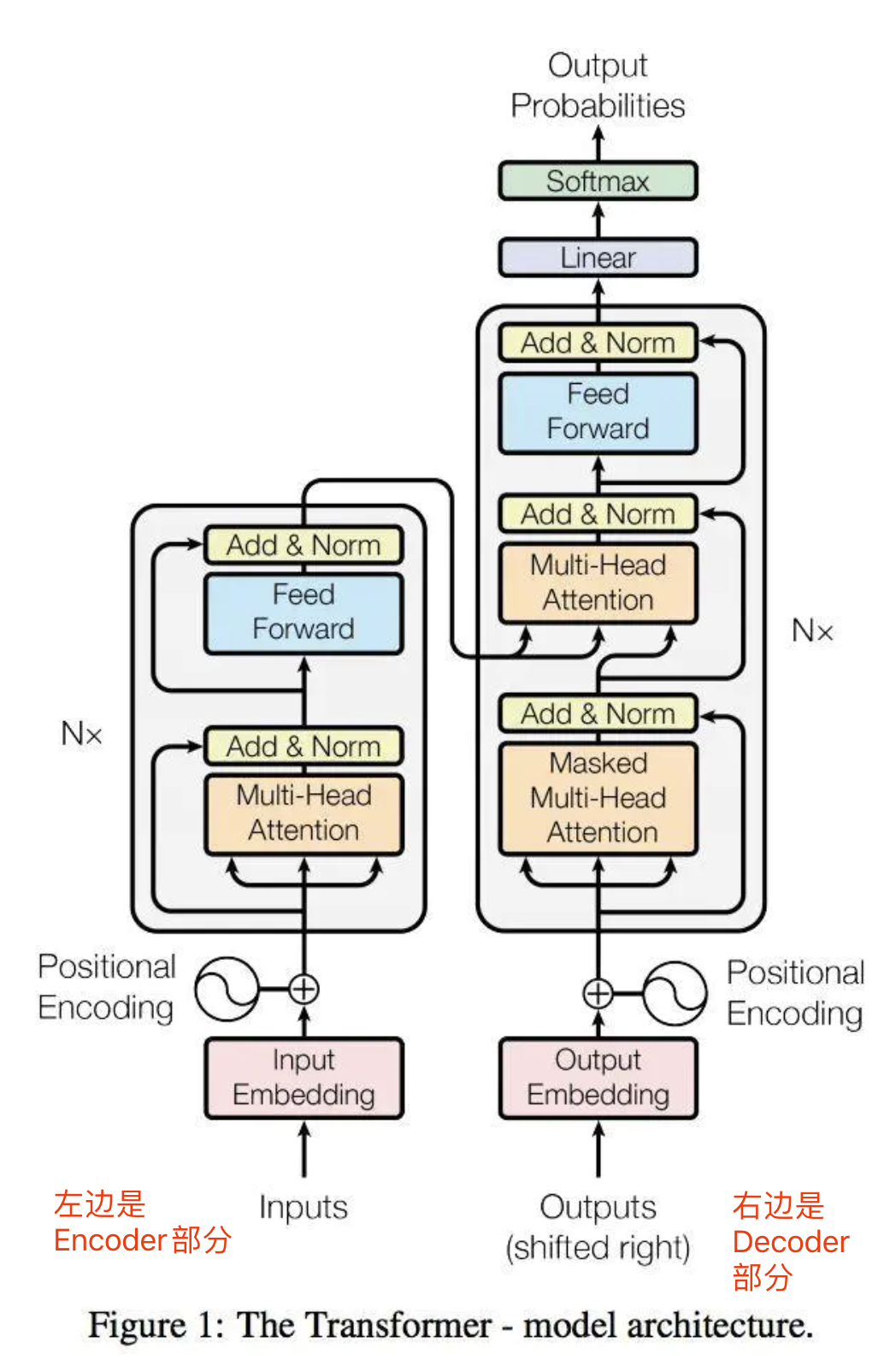

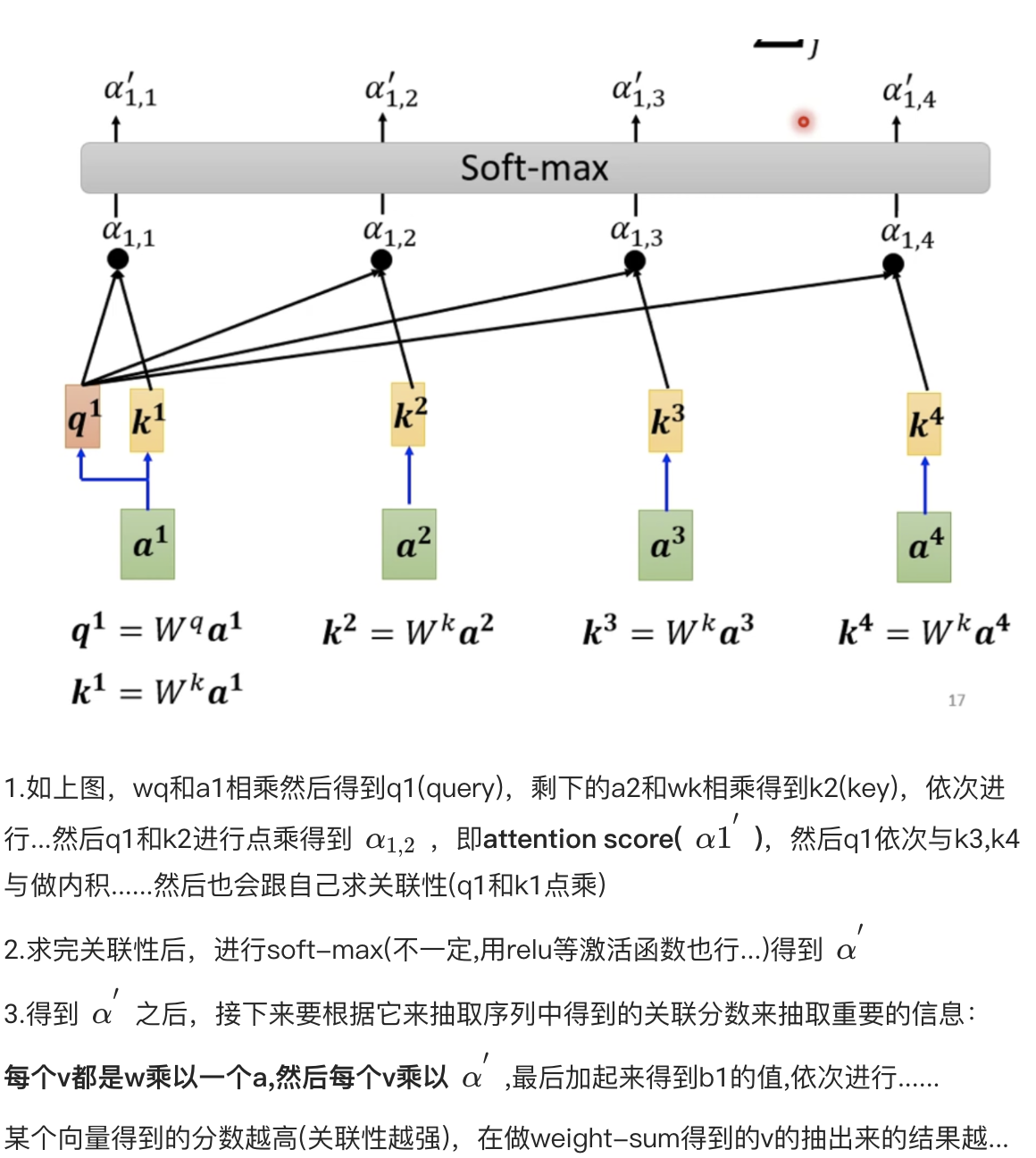
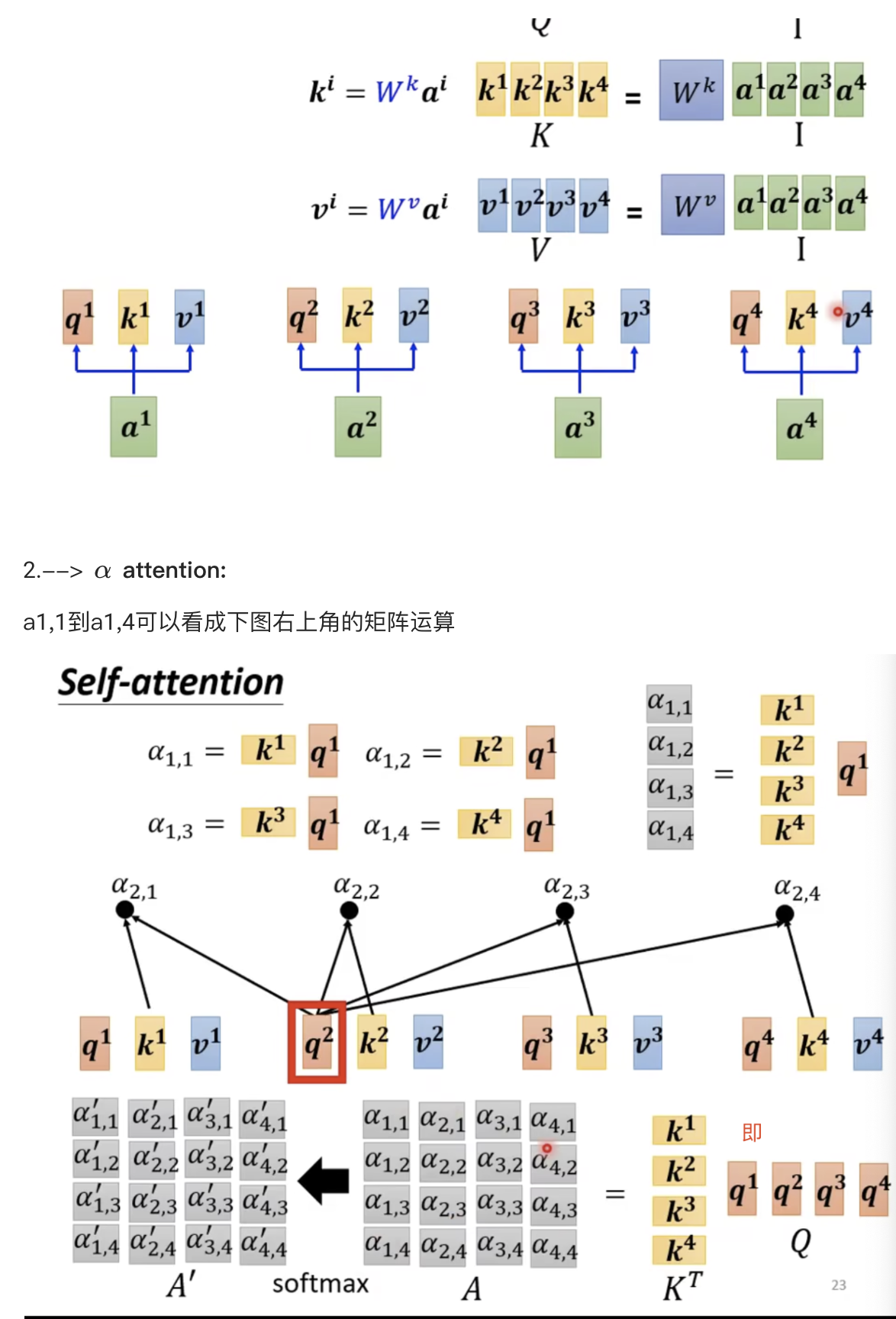

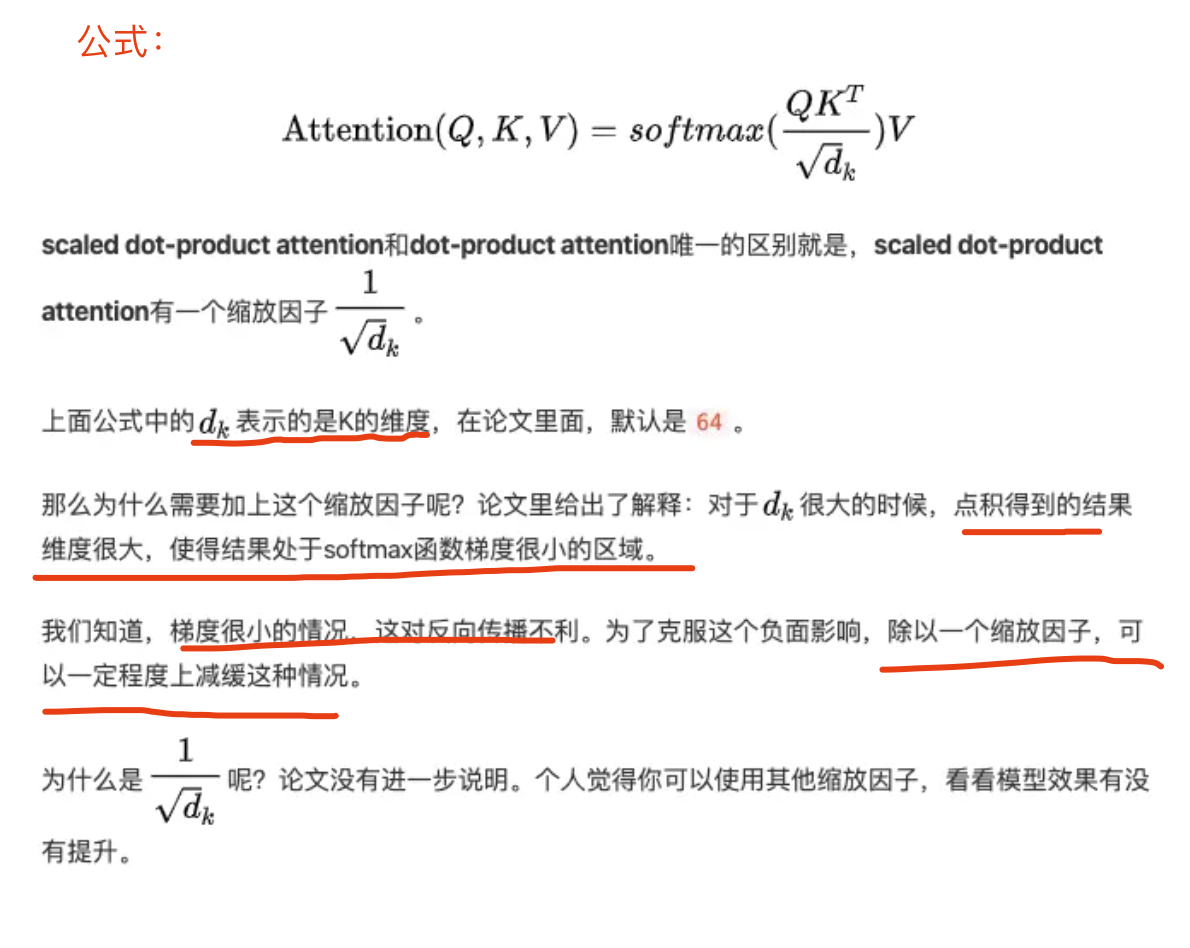

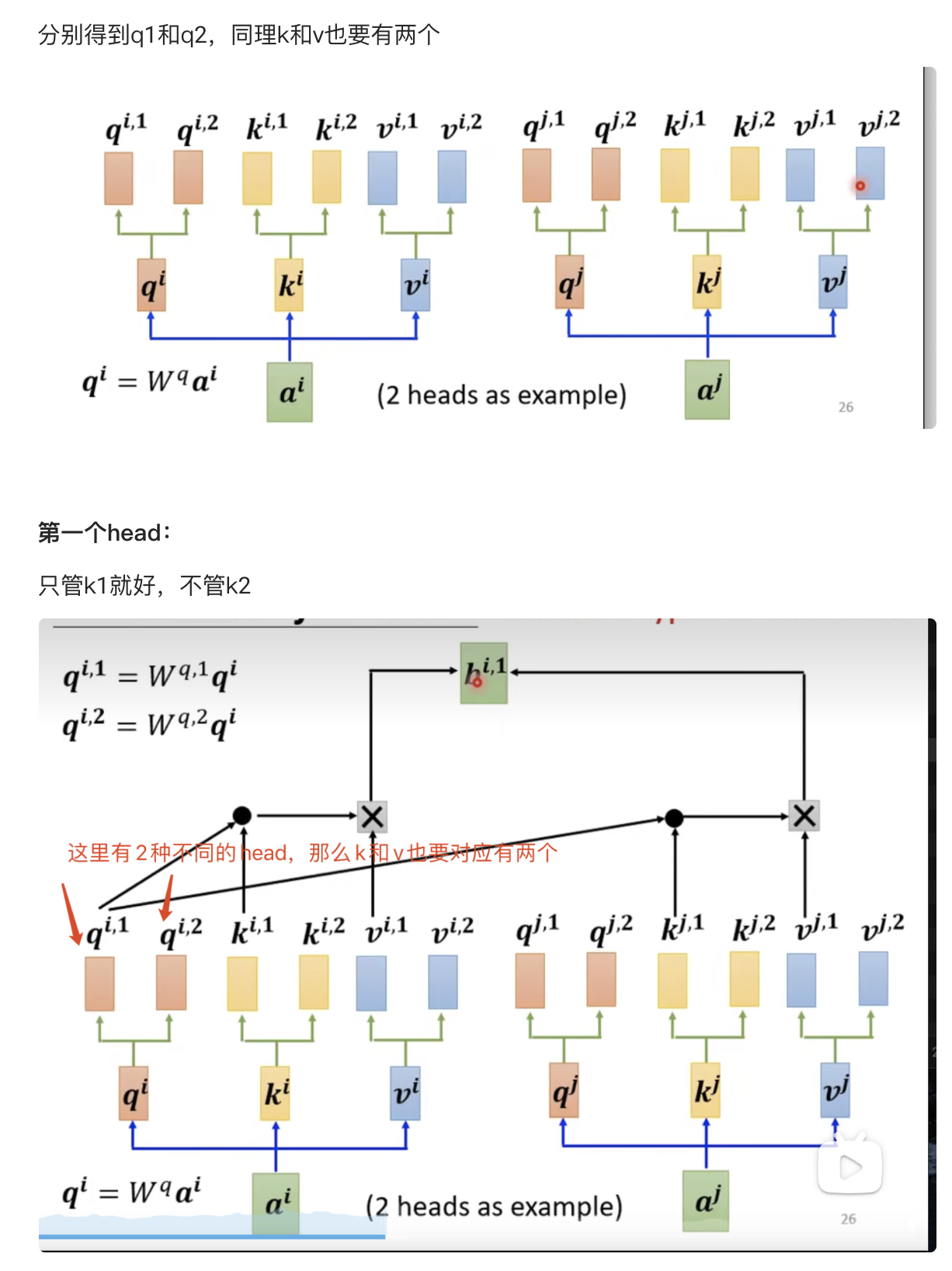 将Q、K、V通过一个线性映射之后,分成
将Q、K、V通过一个线性映射之后,分成
